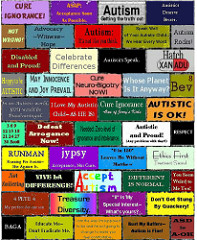“If a cluttered desk is a sign of a cluttered mind, of what, then, is an empty desk?” ~ Albert Einstein
Not all kinds of “messiness” are the same.
Some kinds of mess are the healthy, happy exuvia of just living and doing lots of things. It’s the pieces of the ongoing sewing project, stacks of references for a writing assignment, travel guides and ephemera to trips past and future, and lines of shoes and piles of jackets ready by the front door.
The surfaces are visual storage and reminder areas, helping us organise what we are thinking and working on. They are ergonomically useful both cognitively and physically (think of all the time and effort that would be wasted repeated putting things away and taking them right back out again hours later). If I can find things on my over-full tabletop that serves as my desk, that means it is a workable working-system.
The surfaces are also visual synthesis areas – having a variety of things out helps jog the creative process. There’s a reason why the blank white page or canvas is so daunting! Clutter can incubate creativity; it’s a serendipitous substrate. One of my favorite microbiology stories is how Alexander Fleming discovered the antibiotic properties of Penicillium notatum because he’d left culture plates sitting around, and a spore had floating in through the window, set up housekeeping, and was doing battle against the previously-colonized bacteria. Winnie-the-Pooh author A. A. Milne noted that, “One of the advantages of being disorderly is that one is constantly making exciting discoveries.”
Some kinds of mess is just overflow. It’s sports equipment dumped in a box because the coat closet is full of coats, books piled on floors and random surfaces because the bookcases are full of books, cooking equipment sitting clean-and-ready on counters because the cabinets are full of ingredients and less-frequently-used equipment, and the bottles of lotions and magazines and library books and the bottles of medicine that clutter my bedside because I’ve neither a bedside cabinet to put them in nor space to put that piece of furniture.
Some kinds of mess is just hyperconnectivity. It’s not that there isn’t a perfectly rational place to put something away, but that some things don’t easily resolve to single locations. Does my book on growing and cooking ethnic vegetables belong upstairs with the gardening books or down in the kitchen with the cookery books? Do I keep this roll of string with the office supplies, the cooking gear, the gardening equipment, the craft materials or the cat stuff?
Some kinds of mess is just hyperactivity. There are crocks of cooking utensils and chopsticks on the kitchen counter, a test tube rack of markers on my desk, and a jelly jar of pens and scissors on the kitchen table because we use these things all the time and putting them away somewhere would slow down productivity. It really is impossible to play with Lego blocks without dumping the bin to see all the pieces (we have a floor cloth for dumping the Legos onto to facilitate picking them back up again, so the vacuum sweeper doesn’t eat them).
Speaking of bins, it’s not that I don’t appreciate good storage concepts. I love big plastic bins for storing flower pots, Christmas tree ornaments, train set pieces, sorted quiltmaking scraps, camping gear et cetera. In fact I’ve decided that clear bins are far superior to opaque ones because you don’t have to go digging through the bin to see what’s in it, and also because this bit of visual contact with materials helps remind me that I already own it, so I will be sure to use it again. (They’re also fabulous when moving house because a bin of stuff is pre-packed.)
These are good messes, the stuff that distinguish real homes from unrealistic designer showcases and sterile hotel rooms.
Some kinds of messiness is just clutter, the leftover bits of things since forgotten. It’s out-of-date phone books, pieces to broken things that someone meant to fix months ago and never will, snow mitts scattered about in summer and the bathing trunks left out in winter, decorative holiday tchotchkes that weren’t packed away and have since become part of the scenery, and hobby materials left in desuetude. These are the sorts of useless messes that interfere with good messes because they get in the way and thus use up functional spaces.
Other sorts of messiness are just sloth, and have no redeeming qualities.
Some kinds of messiness is just trash. It’s junk mail and newspapers and adverts and magazines that everyone is done reading, empty shopping bags and packaging materials, expired coupons and old fliers. It makes it hard to find the useful things for which one is looking, and it makes it hard to clean surfaces.
Some kinds of messiness is just dirt. It’s crumbs on tables, and crud on carpeting, toothpaste slugs dried on the sink basin and loose hair around the bathroom, “squissues” (used, squished-up tissues) strewn about, snack wrappers and used dishes piling up, dirty socks and bath towels dropped about, and expired food in the fridge and on the counters. It’s very bad mess, and not only from a health standpoint, but also because it creates and aggravates the despondency and inertia.
The important thing to remember is that it is entirely possible to clean up the clutter, trash and dirt and leave intact the creative messes. In fact, it is important to do so for mental well-being, especially if some residents are prone to depression.








yanub said,
8 January 2007 at 20:44
Hi, Andrea! You are definitely right that there are many kinds of messes. Too bad so many of mine fall into the category of “threw out the tax forms instead of the garbage.”
I added you to my blogroll.
qw88nb88 said,
24 December 2006 at 19:39
Gee BC, you sound like you’re sliding from organelles to chromosomal cross-over there. (-:
Bartholomew Cubbins said,
24 December 2006 at 19:12
Like the post.
Out of convenience I’ll stretch the mess-creativty-science analogy and bring up the impact of membrane compartmentalization on evolution (diversity) during the transition from prebiotic life. One might consider one of my discreet piles as a distinct idea that grows and shinks over time. When a page inadvertently moves from one pile to another, the idea in effect evolves until I decide that the idea is ripe for either picking and pursuing or directing to the wastebasket.
Catana said,
24 December 2006 at 14:52
I probably couldn’t function without my “good” messes. That’s probably why I tend to look at people with a “one place for everything, and everything in its place” kind of mind as rigid rather than organized.
Wonderful post.
Rose said,
24 December 2006 at 0:01
LOVED YOUR QUOTE: I needed a good laugh!
susanne said,
23 December 2006 at 22:54
OOOOOOOOOOOOOOOOh that s a description of my life and household.
Do you happen to know me?And my messy teenagedaughter…
Anyway,yes, you are so right about the creativity of mess-one of my costumers told me that I am the only person who can make gold rings that have moss growing on them…Cheers Susanne
sharon said,
23 December 2006 at 21:18
Andrea, I’ve spent some time over the past few days trying to contain our clutter monster in preparation for a load of new toys and stuff due to be acquired over the next few days. I’ve recycled, dumped and given many bags to the charity shops. Sometimes it really bugs me just how much if my life is spent picking stuff up and putting it away/ My o.h. is even less forgiving of a bit of child-made mess than I am. Oh well, it’s all part of family life!
I hope you and your family have a wonderful Christmas, and wish you all the best for 2007.